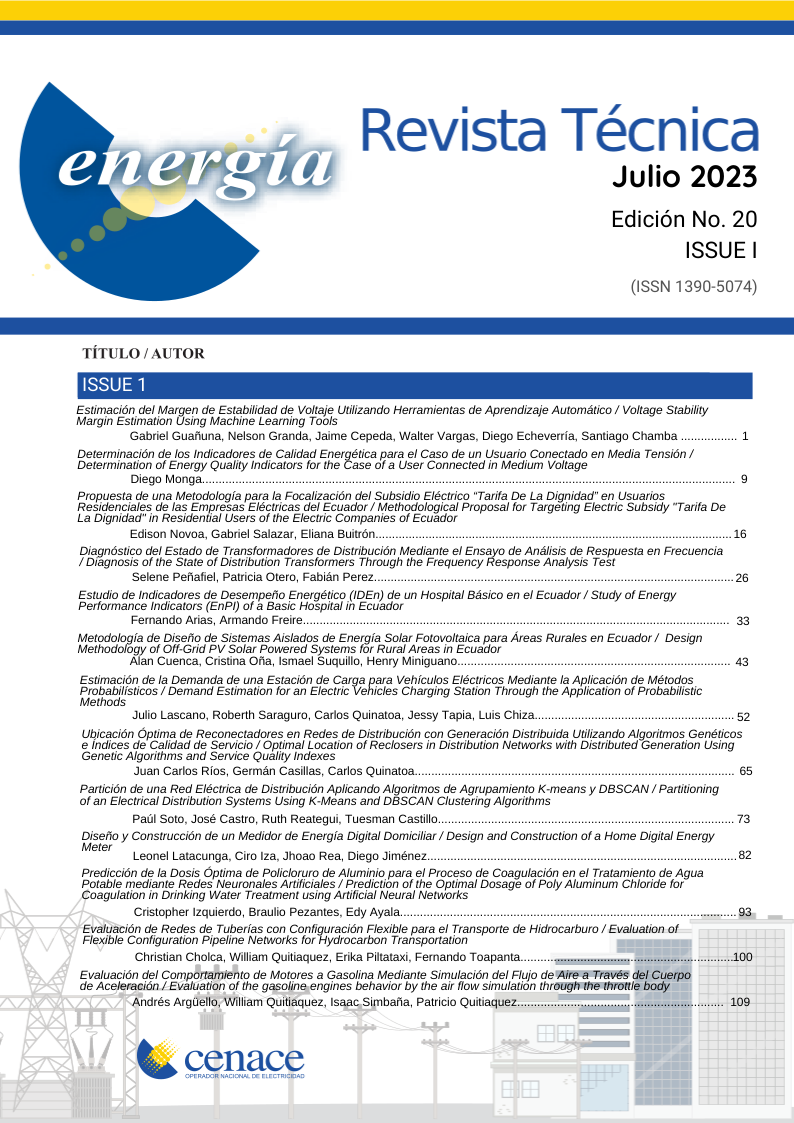Evaluation of Flexible Configuration Pipeline Networks for Hydrocarbon Transportation
Main Article Content
Abstract
Pipelines are currently the main method of transporting fluids from one place to another within an industrial plant. The present investigation studies the piping configuration of a hydrocarbon transport pump system. An investigation was carried out to identify the different loads present in pump system designs due to self-weight and thermal operating effects to reduce the stresses and displacements acting on the piping, guaranteeing its mechanical integrity and the safety of equipment and plant personnel. The model development and analysis has performed in the specialized software Bently AutoPIPE under static conditions; the operating temperature and pressure data are 100 °F and 320 psi, respectively. For the analysis, two configuration models were used pipes with rigid and flexible system, allowing to compare results and validate that the stresses in pipes and pumps nozzles are within the allowable loads according to ASME B31.3 and API 610 standards. Based on the analysis results, the sustained and thermal stresses are 16.3 and 14.4 ksi, values that represent approximately 75 % of the maximum stress of the system.
Downloads
Article Details

This work is licensed under a Creative Commons Attribution-NonCommercial 4.0 International License.
Aviso de Derechos de Autor
La Revista Técnica "energía" está bajo licencia internacional Creative Commons Reconocimiento-NoComercial 4.0.
References
F. Rumiche y E. Indacochea, «Estudios de Caso de Fallas y Accidentes en Gasoductos y Oleoductos». .
H. XU y B. WANG, «Vibration Analysis of High Pressure Mud Piping Systems and Vibration Reduction Method», en 2020 3rd World Conference on Mechanical Engineering and Intelligent Manufacturing (WCMEIM), 2020, pp. 732-737, doi: 10.1109/WCMEIM52463.2020.00157.
J. Morales, W. Quitiaquez, y I. Simbaña, «Modelos de optimización matemática aplicables al sector downstream y midstream del petróleo. Revisión de la literatura y dirección de investigaciones futuras», Rev. Técnica «energía», vol. 17, n.o 1, pp. 103-111, 2020, doi: 10.37116/revistaenergia.v17.n1.2020.398.
R. N. Rao, M. Maiya, S. Prabhu, G. Santhosh, y G. Hebbar, «The analysis of a piping system for improvement of a system in a process unit», Mater. Today Proc., vol. 46, pp. 2791-2797, 2021, doi: https://doi.org/10.1016/j.matpr.2021.02.595.
J. R y R. K, «Design and Analysis of Piping System with Supports Using CAESAR II», World Acad. Sci. Eng. Technol. Int. J. Comput. Syst. Eng., vol. 10, n.o 5, pp. 1-5, 2016.
A. K. Jha, S. Kennedy, y K. K. Jha, «Pipe Stress Analysis of Pump System in Process Plant», IOP Conf. Ser. Mater. Sci. Eng., vol. 1149, n.o 1, p. 12004, 2021, doi: 10.1088/1757-899x/1149/1/012004.
H. Lu, G. Ma, X. Li, y S. Wu, «Stress analysis of LNG storage tank outlet pipes and flanges», Energies, vol. 11, n.o 4, 2018, doi: 10.3390/en11040877.
A. K. Verma, B. K. Yadav, A. Gandhi, A. Saraswat, S. Verma, y E. R. Kumar, «3D modelling of loop layout, pipe stress analysis and structural responses of high-pressure high-temperature experimental helium cooling loop (EHCL)», Fusion Eng. Des., vol. 145, pp. 87-93, 2019, doi: https://doi.org/10.1016/j.fusengdes.2019.05.015.
S. Saha, «A study on the static interaction between primary and secondary systems comprising structures equipment and piping», Int. J. Press. Vessel. Pip., vol. 170, pp. 59-65, 2019, doi: https://doi.org/10.1016/j.ijpvp.2019.01.009.
U. Zahid, S. Z. Khan, M. A. Khan, H. J. Bukhari, I. Ahmed, y K. A. Khan, «A methodology for flexibility analysis of process piping», Proc. Inst. Mech. Eng. Part E J. Process Mech. Eng., vol. 232, n.o 6, pp. 751-761, 2018, doi: 10.1177/0954408917738963.
B. Shehadeh, S. I. Ranganathan, y F. H. Abed, «Optimization of piping expansion loops using ASME B31.3», Proc. Inst. Mech. Eng. Part E J. Process Mech. Eng., vol. 230, n.o 1, pp. 56-64, 2016, doi: 10.1177/0954408914532808.
H. Saputra et al., «ANALISA TEGANGAN PIPA PADA SISTEM BALLAST KAPAL TUGBOAT 24 METER MENGGUNAKAN AUTOPIPE», Jurnal Teknologi dan Riset Terapan (JATRA), vol. 3, n.o 1. pp. 2685-4910, 2021.
Reglamento De Operaciones Hidrocarburiferas, «Reglamento De Operaciones Hidrocarburiferas», pp. 1-58, 2018.
B. Li, X. Li, Y. Miao, y H. Yang, «Application of Stress Analysis Software in Oil and Gas Pipeline», IOP Conf. Ser. Earth Environ. Sci., vol. 558, p. 22006, 2020, doi: 10.1088/1755-1315/558/2/022006.
S. U. Bhave y P. Sonawane, «Analysis of Pump Piping Based on Piping Configurations», IJIRST-International J. Innov. Res. Sci. Technol., vol. 2, 2016.
The American Society of MechanicalEngineeres, ASME B31.3-2020. New York, 2021.
M. U. Pawara et al., «Bilge System Design on 500 GT Ferry for Bulukumba-Selayar Route», en IOP Conference Series: Earth and Environmental Science, 2021, vol. 921, n.o 1, doi: 10.1088/1755-1315/921/1/012010.
N. Jaćimović, «Uncertanties in expansion stress evaluation criteria in piping codes», Int. J. Press. Vessel. Pip., vol. 169, pp. 230-241, 2019, doi: https://doi.org/10.1016/j.ijpvp.2019.01.003.
B. G. N. Muthanna, O. Bouledroua, M. Meriem-Benziane, M. R. Setvati, y M. B. Djukic, «Assessment of corroded API 5L X52 pipe elbow using a modified failure assessment diagram», Int. J. Press. Vessel. Pip., vol. 190, p. 104291, 2021, doi: https://doi.org/10.1016/j.ijpvp.2020.104291.
A. W. Husodo, P. Mahardhika, V. V. A. Vadilla, S. P. J. T. P. Kapal, y P. P. N. Surabaya, «ANALISA FLEKSIBILITAS SISTEM PERPIPAAN PADA FATTY ACID PLANT AKIBAT PERGESERAN POSISI EVAPORATOR», J. Integr. |, vol. 112, n.o 2, pp. 2548-9828, 2019.
S.-Y. Hwang, M.-S. Kim, y J.-H. Lee, «Thermal Stress Analysis of Process Piping System Installed on LNG Vessel Subject to Hull Design Loads», J. Mar. Sci. Eng., vol. 8, n.o 11, 2020, doi: 10.3390/jmse8110926.
K. M, design-of-piping-systems-m-w-kellogg1956, vol. 2. 2019.
A. N. Standard, «Enterprise-Control System Integration Part 1 : Models and Terminology», n.o July. 2000.
S. Bisht y D. K. Dodeja, «Piping Stress Analysis of a Hypothetical Oil Refinery Plant Having Separate Suction & Discharge Lines», IJSRD-International J. Sci. Res. Dev., vol. 3, pp. 613-2321, 2015.
API, «API 610 , 11th». pp. 1-218, 2010.



